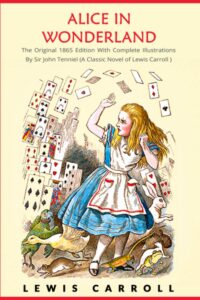
Book Summary
Alice’s Adventures in Wonderland is a magical and imaginative story written by Lewis Carroll. It takes you on a journey with a young girl named Alice who falls down a rabbit hole and enters a strange and whimsical world.
This book is full of exciting adventures and peculiar characters that will make you laugh and wonder. Alice meets talking animals, like the Cheshire Cat with its big grin, and the White Rabbit who is always in a hurry. She attends a tea party with the Mad Hatter and the March Hare, where everything is topsy-turvy. Alice even plays croquet with the Queen of Hearts, who is always shouting “Off with their heads!”
Alice’s Adventures in Wonderland is a story that teaches us about the power of imagination and the importance of being curious. It shows us that sometimes, things may not make sense, but that’s okay! The book encourages us to embrace our uniqueness and to be open to new experiences.
The author, Lewis Carroll, uses clever wordplay and nonsensical situations to create a world that is both strange and fascinating. The story is filled with riddles and puzzles, which will keep you engaged and thinking.
Lewis Carroll, whose real name was Charles Lutwidge Dodgson, was a mathematician and writer. He was born in England in 1832 and loved to entertain children with his stories. Carroll’s imaginative tales, like Alice’s Adventures in Wonderland, have become classics in children’s literature and continue to be loved by readers of all ages.
Alice’s Adventures in Wonderland, written by Lewis Carroll, is a timeless classic that has captivated audiences for over a century. First published in 1865, the novel is a surreal exploration of a young girl’s journey through a fantastical world filled with peculiar characters and absurd situations. The book is a masterpiece of children’s literature, but it also holds a wealth of deeper meanings and interpretations that make it a fascinating read for older audiences.
The story begins with Alice, a young, curious girl, who falls down a rabbit hole into Wonderland, a place where logic is turned on its head. Here, she encounters a variety of eccentric characters, including the White Rabbit, the Mad Hatter, the Queen of Hearts, and the Cheshire Cat. Each character presents Alice with riddles, paradoxes, and nonsensical rules that challenge her understanding of reality.
Carroll’s narrative style is engaging, filled with humor, wit, and a sense of whimsy that makes the book a delightful read. The author’s use of language is playful and inventive, with puns, parodies, and linguistic puzzles that add depth to the story. The illustrations by Sir John Tenniel, which have become iconic representations of the characters, further enhance the reading experience.
On the surface, Alice’s Adventures in Wonderland is a charming and imaginative children’s story. However, a closer look reveals a complex exploration of themes such as identity, reality, and the nature of language. Alice’s journey can be seen as a metaphor for the transition from childhood to adulthood, a period marked by confusion, change, and the struggle to make sense of the world.
The book also reflects Carroll’s interest in logic and mathematics. The nonsensical rules and paradoxes that Alice encounters in Wonderland can be seen as a critique of the rigid and often arbitrary rules of Victorian society. Furthermore, the book’s exploration of language and meaning has made it a significant work in the field of semiotics.
Lewis Carroll, whose real name was Charles Lutwidge Dodgson, was an English writer, mathematician, logician, and photographer. He is best known for his works Alice’s Adventures in Wonderland and its sequel Through the Looking-Glass. Carroll’s writing is characterized by his unique blend of humor, fantasy, and intellectual puzzles.
Carroll was also a lecturer in mathematics at Christ Church, Oxford. His interest in logic and word play is evident in his writing, which often includes complex riddles and linguistic games. Despite his success as a writer, Carroll remained a private individual, and much of his life remains a mystery.
In conclusion, Alice’s Adventures in Wonderland is a rich and multi-layered work that continues to captivate readers with its imaginative storytelling, clever wordplay, and profound exploration of complex themes. It is a book that can be enjoyed by children for its fantastical elements and by adults for its deeper philosophical insights.
Don Quixote by Miguel de Cervantes
Miguel de Cervantes
Read Now →